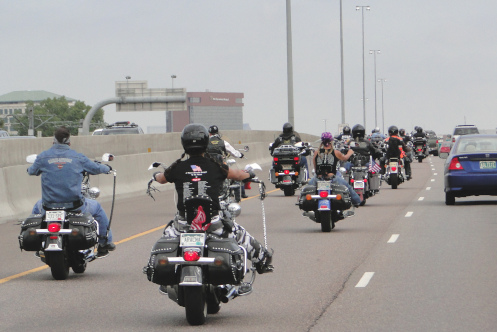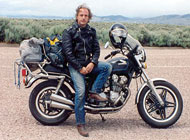Examiner Resurrection: A Motorcycle Ride Captain Discusses Safe Group Riding
There are motorcyclists who get together with friends and go for a ride as a group. And then there are motorcyclists who go on group rides. The two can be vastly different. While the former can be very loose and unstructured, with different riders taking the lead periodically as they feel so moved, the latter is a very structured event.
On a group ride, particularly the sorts of rides that Harley Owners Groups (HOGs) affiliated with dealerships do, safety is generally a top priority and clearly defined leadership and rules are paramount. At minimum you’ll have a Ride Captain in the lead and a sweep rider bringing up the rear, often in communication with each other via radio.
Alan Baumbach is an experienced Ride Captain who lives in Denver. As a Harley rider he belongs to several local HOG chapters and ridden with many groups. Alan has very definite ideas about motorcycle safety and he has stories to tell. We let him talk.
“We were with a sizable group coming down I-70, coming back to Denver from Grand Junction. I was leading. I think there were 12-15 bikes in the group. I’m checking my mirrors all the time and everybody’s all lined up and I can see everybody, and we’re good. But every so often I’d look back and it was like half the group was gone. What happened?! A minute or so would go by, and I’d be checking my mirrors, and they’d catch back up to me. And then I’d look back again and they’d disappeared again. Finally we stopped for a fuel stop and one of the people who was in the last half of the group came up to me and said, ‘Alan, I think you need to talk to so-and-so because he’s sightseeing and he is slingshotting.’ He was slowing down because it was his first time in Colorado, he wanted to see the sights, and then he was speeding up. And he was slowing down and he was speeding up. So he was slingshotting in the group and driving everybody nuts. Because you don’t want to pass when you’re in a group.
“There have been times when I’ve been on rides where people are novices and don’t quite know how to ride. I don’t know if it’s a situation where they feel they have to keep up with the group, or they are not riding their own ride, or what. But they crash. And that’s always sad to see. I’ve never been on one that was too serious, but I’ve been on some where people broke bones. They had to have the ambulance come and take them away.”
Why did they crash?
“Target fixation. I’ve even seen it in myself sometimes. I think anyone who rides any time, any distance, has seen that there’s a natural tendency to fixate on a target. And where you look is where you’re going to go. And if you look for the side of the road you’re going to go to the side of the road. And if you look for the chuck hole, you’re going to go into the chuck hole.
“I think a lot of people, too, just never learned how to counter-steer. It’s counter-intuitive to what you think. You describe it to someone who has never ridden a motorcycle or a bicycle and they think that you’re nuts. It’s like, no, that’s really how you steer.”
Do many of the people on dealer rides tend to be new riders looking for someone to ride with?
“I’ve been on rides with a number of dealerships and it varies by chapter. I’d say of the rides I’ve been on there have been a lot of new riders. But I’ve been on other rides where you’ve got a lot of experienced riders. It is so nice to ride with experienced riders who know what they’re doing. They know the signals, they know how to stagger, they know single-file when you’re on a twisty mountain road. It’s automatic. I think it’s intimidating for a new rider to come into a group and everything is unfamiliar. That’s one of the things I think, anytime you’re riding with a group, the Ride Captain and the leaders and the sweeps all should go over who’s new, ride your own ride, go over all the signals, do you have any questions, do you have any concerns, things of that nature, before you ever step over the bike and fire it up and go. I think that helps a lot and if there’s a new rider, people are watching out for him. If someone doesn’t raise their hand and say ‘I’m new and I’ve never done this before and I don’t know quite what to do,’ people are making assumptions that you’ve ridden before.
“I think six to eight is the ideal size for a group. When it gets beyond eight the leader can’t see all the way to the back. Even if you’re on radios with the sweep at the end you can’t see everything that’s going on.
Ride your own ride
“I tell people all the time, if something happens that you feel you need to pull over, pull over. Don’t think, ‘Oh I’ve got to stay with the group.’ If you’re running out of gas, if you hit something, if the bike’s not operating right, something of that nature, don’t be pressured by the group to continue the ride.
“I’ve ridden on rides where we want to try to keep it a reasonable space as far as distance, but not excessive, and if you start pushing it too excessive you know exactly what’s going to happen: cars are going to pull in, and the next thing you know your one group is now two groups or three groups, and you’ve got a mess. Trying to keep it tight . . . with experienced riders, not a problem. With new riders, they’re still uncertain of their capabilities, they’re uncertain what they can do as far as handling the bike and stopping the bike, and it may be intimidating to ride in a relatively tight formation, even though it’s staggered. And so they start leaving some space. I’ve talked to some of them and said, ‘You know, if you can, tighten it up. I understand if you’re not feeling comfortable with it, but if you can tighten it up that will help to make sure that cars don’t try to split us up.’ Again, having a group that is a small group instead of a large group so the cars can feel comfortable getting around the group is a big thing. Like I said, six to eight bikes is probably ideal as far as size. If you are not comfortable in the situation that you’re in, regardless if it’s a big group or a small group, they’re going too fast, they’re going too slow, whatever, if you’re not comfortable, pull out and do your own thing. But if you’re part of the group, be part of the group.
“I have ridden with a number of chapters and they all have varying levels of discipline. One of the reasons I ride more frequently with the chapter that I do is because they are very disciplined. When we want to ride we want to ride safe. We don’t want an accident. We want people to feel comfortable on the ride. We want it to be an enjoyable experience for everyone. And these are the rules so we can accomplish that. I’ve been on rides where everybody’s clustered around waiting for the ride to start and the leader comes out and says, ‘Well, everybody ready to go?’, jumps on his bike, and takes off. And it’s like, nobody else has started up their bike, maybe they’re adjusting their helmet or something of that nature, and now all of a sudden everyone is scrambling to try to catch the leader just to go on the ride. I’ve been on rides, too, where the leader has been oblivious of the group and he’s doing 80-plus miles an hour and the group is just a mile behind him because, it’s like, you shouldn’t be going that fast. Not on the road and the conditions we were on.
No bar hopping
“I’m not a bar hopper. I enjoy a drink after the ride as much as anyone. But I’ve ridden only once with groups that I find out have got to have six beers in three miles. I’m like hold it! Time out! No, no, no, no. This is not what I want to do. I realize there are people like that out there and that’s what they do but I don’t want any part of that. I want to ride safe.
“We were riding over to Grand Junction and I-70 was shut down at the tunnels, shut down in both directions. And they were sending all the traffic over Loveland Pass. This was early September, it was one of those freak weather things where there had been a little bit of snow at night and because it was still early September it had been warm and the snow had melted when it hit the road and it froze. And Loveland Pass was glare ice all the way up to the top and all the way down to the bottom. We had six of us who went up and down that pass and nobody lost it. I mean, there were a few close calls but nobody lost it. But we were doing 10 and 15 miles an hour trying to get up and down that pass. If somebody had gone down, or if we had not been able to control the bikes I think we would have called the ride immediately and said this isn’t worth it. But we had experienced riders, we had people who knew how to handle their bikes. Everybody was conscious that, we’re on ice guys. Watch it! We’re going into a hairpin turn you’d better be darn sure that you’ve got control of that bike. That was one of the best group rides I have ever been on. We put on 650 miles that day but it started out early in the morning and on Loveland Pass, glare ice. Don’t want to repeat that one again any time soon.”
Biker Quote for Today
Life is about moments. Don’t wait for them, create them.
Tags: ride captain

